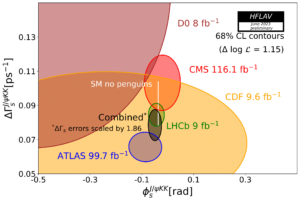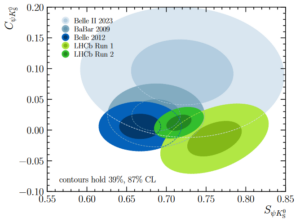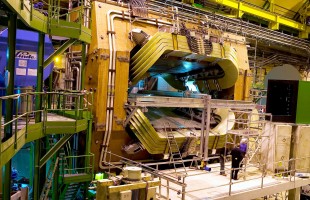Today the LHCb experiment at the Large Hadron Collider at CERN presented important results in the quest to understand the nature and origin of the so-called CP violation.
CP violation means that matter and antimatter behave in different ways. CP violating processes play a crucial role in the search for New Physics beyond the Standard Model. The LHCb collaboration now reported how it has measured two key parameters that determine such matter-antimatter asymmetries. The two measurements presented today in the CERN seminar, are based on a careful analysis of the full data sample of Run 2 of the LHC and are the world’s most precise measurements to date. They are consistent with earlier measurements and with the Standard Model.
Both measurements with the LHCb experiment are derived from decays of B-mesons, which are particles with two quarks, one of which is a bottom-quark. The LHCb experiment was optimized to detect these B-mesons. Nikhef is heavily involved in LHCb, and had a significant role also in these two new analyses.
In the first analysis, the CP-violating phase phi_s was measured in approximately 350.000 decays of strange B-mesons (which consist of a bottom antiquark and a strange quark) into a so-called J/psi-particle and two kaons. Within the Standard Model, this CP-violating phase can be calculated precisely from other measurements. The predicted value is small, and New Physics effects, even if also small, could therefore change its value significantly. The reported Run 2 value is consistent with the Standard Model.

The precision measurement of this key parameter is one of the most important goals of the LHCb experiment. In the presented measurement, LHCb physicists, among whom Nikhef PhD candidate Valeriia Lukashenko and other Nikhef colleagues, obtained an already very precise result from the analysis of the combined Run 2 and Run 1 data samples. The larger Run 3 data sample to be collected with the upgraded LHCb detector will allow to reach even higher precision in the future and, therefore, possibly to detect manifestation of New Physics effects. “The measurement is very complex and seeing the result after all the hard work is really exciting,” says Valeriia Lukashenko. “Especially, as it is the most precise in the world! But I am impatiently waiting for more data from Run 3 and later Run 4, with which, I hope, we can see first hints of new physics.”
In the second analysis, a measurement of the angle beta of the so-called unitarity triangle was done. The unitarity triangle is a geometrical representation of CP violation and its associated parameters. The properties of the triangle can be measured independently in different decays of B-mesons, and should provide a consistent description of the triangle. Any discrepancy would point to signs of New Physics beyond the Standard Model.

The measurement reported today uses three different decay modes of neutral B-mesons to determine the angle beta. The announced value of this parameter for the Run 2 data sample shows clearly a higher precision than previous measurements, and is consistent with the predictions of the Standard Model. Nikhef researcher Wouter Hulsbergen contributed to the measurement as part of the analysis team: “In a hadron collider like the LHC, this measurement is more difficult to perform than in previous electron-colliders. But with the large data sample available at the LHC and with the LHCb-experiment being designed for this job, we succeeded to perform the most precise single measurement of this parameter to date.”
